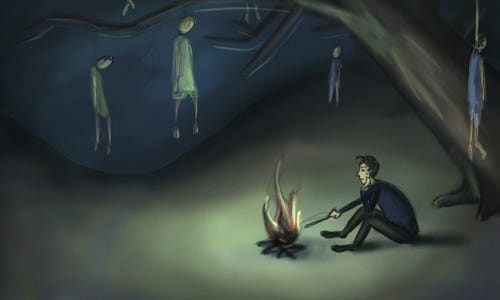From THE CONCEPT OF ANXIETY (1844)
On learning to be anxious.
“In one of Grimm’s fairy tales there is a story of a young man who goes in search of adventure in order to learn what it is to be in anxiety (at ængstes). … This is an adventure that every human being must go through—to learn to be anxious in order that he may not perish either by never having been anxious or by sinking into anxiety (Angesten). Whoever has learned to be anxious in the right way has learned the ultimate.”
In 1812, the Brothers Grimm published their now famous collection of folk stories, Children’s and Household Tales (Kinder- und Hausmärchen). Early in the book’s first volume, they included “Tale of a Youth Who Went Forth to Learn Fear” (Märchen von einem, der auszog das Fürchten zu lernen). It is one of the more comic stories in the Grimm corpus, depicting a young man who is frustrated by his inability to experience fear. With this in mind, he agrees to spend three nights in a haunted castle, though, ironically, it is not there that he finally comes to shudder in fright.
An avid (and discriminating) reader of fairy tales, Kierkegaard here uses "“Tale of a Youth Who Went Forth to Learn Fear” to make a serious point: in earthly life, there is no evading “fear” (Frygt) or “anxiety” (Angst). In one sense, this is good news, since the experience of Angst indicates the expansive potential of the human self. On the other hand, one can become so awash in fearful possibility that one “sinks into” it. Hence, according to Kierkegaard’s pseudonym Vigilius Haufniensis, the young man in the Grimms’ fairy tale has it right: one must “learn fear,” if one is to ultimately be happy.


